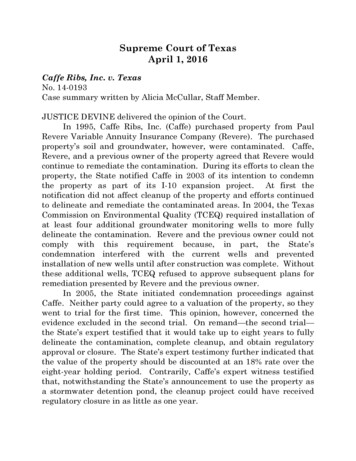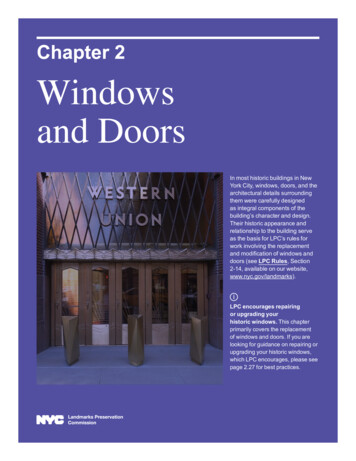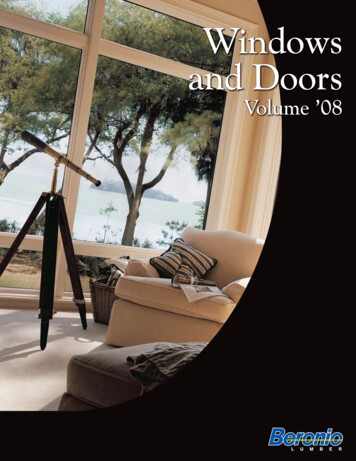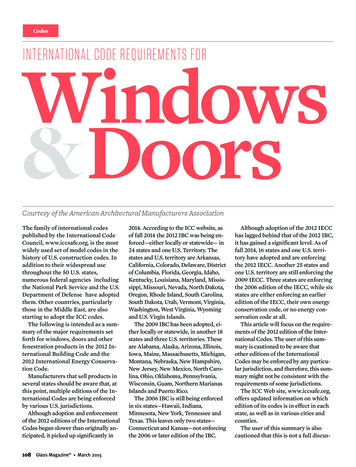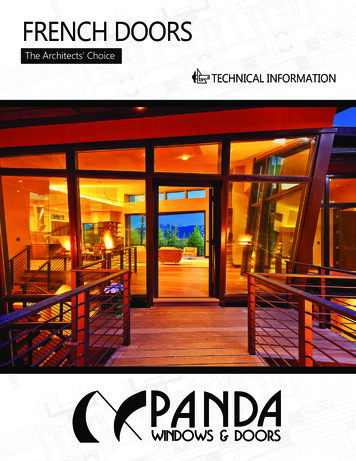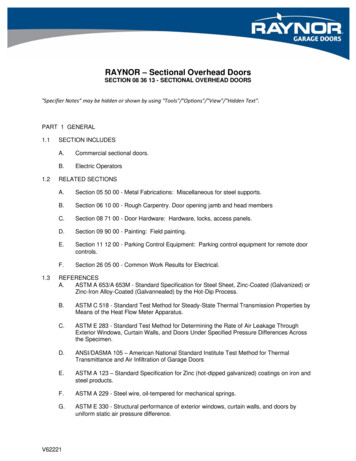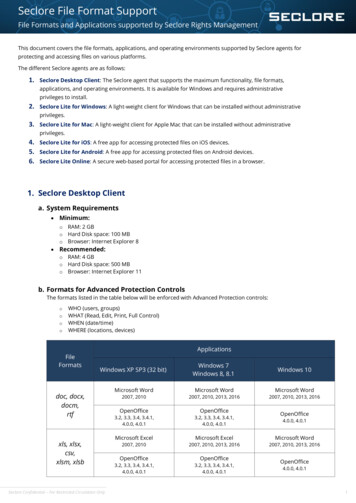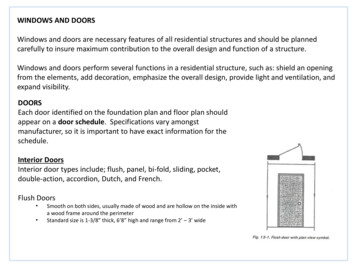
Transcription
WINDOWS AND DOORSWindows and doors are necessary features of all residential structures and should be plannedcarefully to insure maximum contribution to the overall design and function of a structure.Windows and doors perform several functions in a residential structure, such as: shield an openingfrom the elements, add decoration, emphasize the overall design, provide light and ventilation, andexpand visibility.DOORSEach door identified on the foundation plan and floor plan shouldappear on a door schedule. Specifications vary amongstmanufacturer, so it is important to have exact information for theschedule.Interior DoorsInterior door types include; flush, panel, bi-fold, sliding, pocket,double-action, accordion, Dutch, and French.Flush Doors Smooth on both sides, usually made of wood and are hollow on the inside witha wood frame around the perimeterStandard size is 1-3/8” thick, 6’8” high and range from 2’ – 3’ wide
Panel Doors Panel doors have a heavy frame around the outside and generally havecross members that form small panelsThe vertical members are called stilesThe horizontal pieces are called railsBi-Fold Doors A bi-fold door is made of two parts that together form the doorPopular as closet doors and are seldom used for other applicationsInstalled in pairs with each door being the same width, which ranges from1’ – 2’Standard height 6’8” – 8’Thickness of 1-1/8” for wood doors and 1” for metalSliding Doors Sliding or bi-pass doors are popular where there are large openingsFrequently used as closet doorsAny number of doors may be usedWidth is not critical because doors are hung from a trackGlides are installed on the floor to prevent swingingMay be flush, paneled or louveredUsually constructed from woodPocket Doors Usually a flush door and is a variation of a sliding doorUsually, only one doorIt is hung from a track mount, and rests in a wall pocketFrequently used between rooms such as the kitchen and dining roomMost Common Door
Double Action Doors Are hinged in such a way that they may swingthrough an arc of 180 degreesA special double-action, spring-loaded hinge is usedGenerally used between rooms that experience agreat deal of traffic and require the door be shutmost of the timeMay be single or double doorsMay be flush, panel or louveredAccordion Doors Frequently used to close large openings where bifold or sliding doors would not be acceptableRequire little spaceMade of a variety of materials: wood, plastic, fabricMounted on an above trackDutch Doors Made of two parts, an upper and a lowerFrench Doors Panel doors with the panels made of glassMost popular where the door leads to a patio orterrace but also used between rooms
Exterior DoorsExterior residential doors are similar to some of theinterior doors, but have decided differences. They areusually not hollow core, thicker than interior doorsand may have one or more panels to provide visibility.Flush DoorsUsually 1-3/4” thick, 6’8” high and 3’ wideOne of the most popularProduced from wood and metalPanel Doors Available in a variety of stylesConstructed from woodProduced in the same sizes as flush doorsSliding and Swinging Glass Doors Sliding doors are usually made of woodFollow typical sliding glass door sizesGarage Doors Two types account for most of the doors used: Overheadsectional and one-piece overheadAvailable in wood, metal and plastics
WINDOWSWhen selecting windows, it is important to remember theirfunction. They admit light, provide fresh air, ventilation,and add detail, balance and design.A window schedule provides pertinent information aboutthe windows and must be precise. It can be placed on thesame sheet as the floor plan or elevation plan.Sliding Windows The most common types are double-hung (most common) andhorizontal slidingHave two sashes, which slide up and down in groovesSwinging Windows The most common type are casement, awning, hopper and jalousiewindowsCasement Hinged at the side which swing outwardAwning Hinged at the top and swings out at an angle like anawningHopper Usually an in-swinging windowIs hinged at the bottomPopular for basementsJalousie Has a series of narrow horizontal glass slatsMost Common Window
Fixed Purpose is to provide a view and or admit light, butnot ventilationExamples include: picture windows, circle topwindows, glass block and random shapedPicture Fixed-glass units and usually largeCome in fixed sizes or custom sizesCircle Top Can be installed by themselves or in conjunction withother windowsSkylight and Clerestory Windows Used to admit light and ventilation into areas that receive little orno natural lightSkylights Located on the roofCome in a variety of shapes, but the most common isrectangularClerestory Placed high on a wall
Works CitedKicklighter, Clois E., Ronald J. Baird, and Joan C. Kicklighter. Architecture: Residential Drawing andDesign. South Holland, IL: Goodheart-Willcox, 1995. Print.
Exterior Doors Exterior residential doors are similar to some of the interior doors, but have decided differences. They are usually not hollow core, thicker than interior doors and may have one or more panels to provide visibility. Flush Doors Usually 1-3/4" thick, 6'8" high and 3' wide One of the most popular Produced from wood and metal

